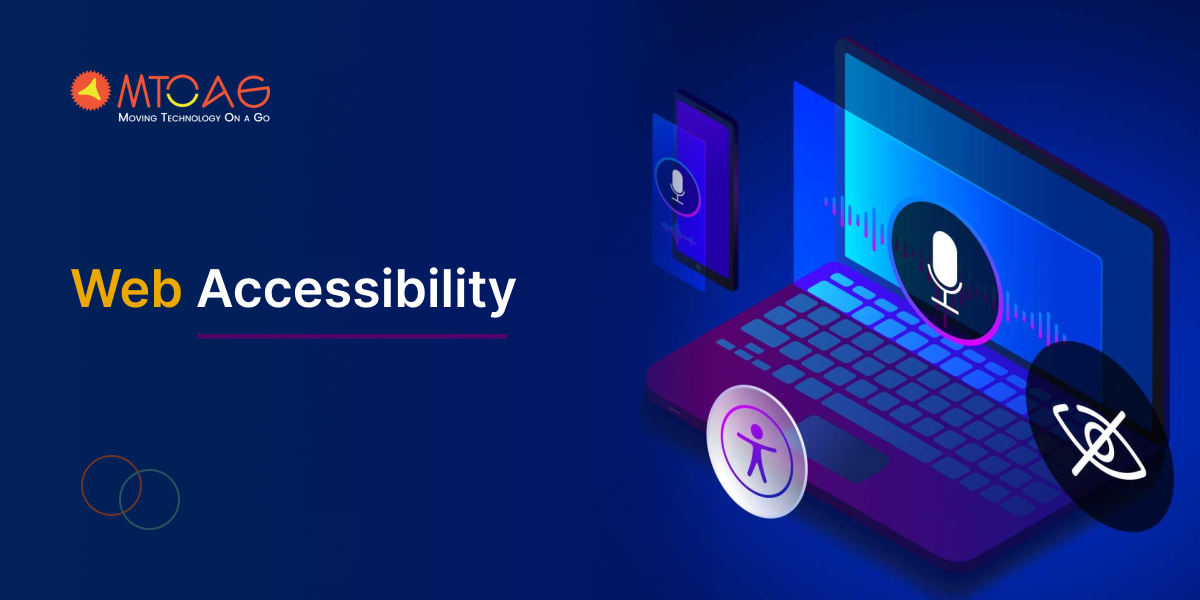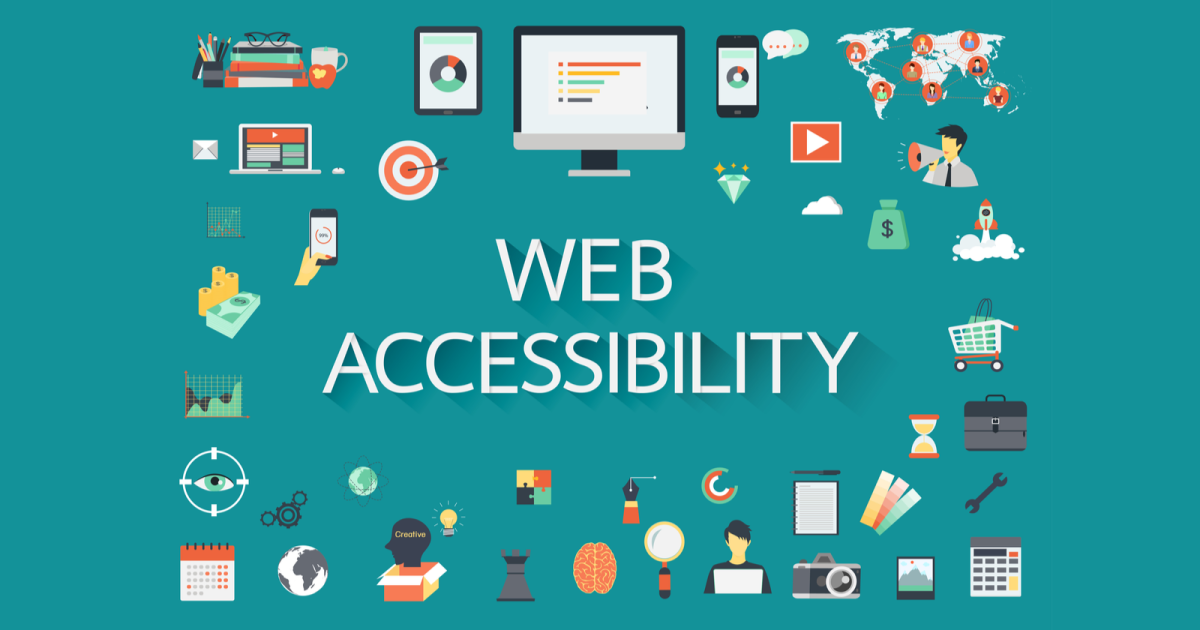2500+
Successful Projects

Whether you own a web development company or an e-commerce website, you want to drive as many people to your website as possible. That entails giving website accessibility top priority to ensure that as many people as possible can use your site.
Website accessibility ensures that your website is usable by all users, including those with disabilities or impairments. Using a range of tools, resources, and advice can make the process of building an inclusive website much simpler.
Table of Contents
In this article, we'll cover everything you need to know about website accessibility, including why it's so important, how to assess your website's accessibility (and hurdles), and a comprehensive guide to creating highly accessible web pages. Now, let's get going!

The degree to which a website is usable by people with impairments is known as its accessibility. Those with limited vision or blindness, hearing loss or deafness, mobility issues, cognitive impairments, and other limitations might all fall under this category. It entails creating your website with accessibility and functionality in mind for all users, including those who may need assistive technologies like speech recognition software, screen readers, or specialized input devices.
This concept extends beyond personal assistance. It's about appreciating the variety of online users and acknowledging the value of fair access to the internet. In addition to growing your audience, putting accessibility first encourages inclusiveness and social responsibility.
Additionally, website accessibility complies with several regulatory requirements, including the Americans with Disabilities Act (ADA) in the US and other comparable laws worldwide. To prevent discrimination, these rules mandate that many websites, particularly those owned by governmental organizations and corporations, be accessible to those with disabilities.
When building an accessible website, you need to adhere to four WCAG guidelines. As they say, your website ought to be:

Up to one billion individuals, or 15% of the global population, are estimated by the World Health Organization (WHO) to be disabled. As life expectancies grow, so do the impairment rates, which drive up chronic health issues. Since it is the right of people with disabilities to have equal access to information as those without, we all must collaborate to eliminate obstacles to online accessibility and make digital material accessible.
Website owners must ensure that they are not unintentionally alienating those with impairments. Because the Americans with Disabilities Act (ADA) forbids discrimination based on disability, you may find yourself in legal trouble if your website isn't user-friendly for all users! However, there are other reasons why designing your website with accessibility in mind should come before legal compliance.
An accessible website communicates to potential customers that your business upholds inclusive ideals. Research indicates that companies with more diversity and inclusivity have a 35% higher chance of outperforming industry averages financially. By prioritizing website accessibility, you're not just doing the right thing, you're also setting your business up for potential financial success.
Making a website accessible doesn't have to be hard or time-consuming. By following a few easy steps, you can greatly increase your site's accessibility. This cannot only increase the size of your audience but also support initiatives for online accessibility. You could even encourage others to follow suit, knowing that the process is straightforward and manageable.
It's a good idea to start with understanding where your site is right now, how it compares to best practices and accessibility standards, and what accessibility obstacles you may need to go over with updates or redesigns before diving into advice and techniques for creating an accessible website.
Several approaches exist to assessing your website's accessibility. Let's examine some of the most popular and straightforward choices.
Using an online accessibility tester, such as WAVE Web Accessibility Evaluation Tools, is among the quickest and most straightforward methods to verify your website's accessibility.
You may assess your web pages and content using the WAVE assessment tools to improve accessibility for people with impairments. If you'd want to take it a step further, WAVE tools can help with manual human evaluations of your material and check for compliance with accessibility standards like the WCAG.
To use WAVE, type the URL of the desired webpage into the "Web page address" section and press the arrow button. After that, WAVE will provide a report highlighting any mistakes or possible accessibility problems on that page. To test accessibility straight inside your web browser, install the WAVE extensions for Chrome, Firefox, and Edge.
Several different browser plugins are available for download that may be used in place of WAVE to automatically scan websites for accessibility problems. The Accessible Rich Internet Applications (ARIA) plugin is a popular option for Chrome and Firefox.
The ARIA extension is a free and open-source accessibility tool that lets users personalize how they interact with online content. Its goal is to increase a website's usability for those with disabilities and accessibility for assistive devices such as screen readers.
Install the ARIA extension from the marketplace inside your browser to use it. It may need your activation before it functions.

A fourth approach is to pay an expert to audit your website if you have the funds. This is a particularly fantastic option for anybody who wishes to make accessibility a fundamental value of their online company since it is often the best method to make your website's most thorough analysis accessible.
DreamHost offers Pro Services, including web design, website administration, and more. One of our services is discovering and addressing accessibility problems on your website.
After thoroughly reviewing your web pages, our team of specialists will present you with accessible solutions for any obstacles they find. Contact us right now to arrange a free consultation or to learn more about our Pro Services.
It's time for the exciting part: creating a website that everyone can use and navigate. It's exciting to begin the path toward making your website accessible to all visitors. The stages listed here will assist you through the design process and ensure that your website complies with all applicable technical and regulatory criteria. Now, let's get started.
A list of the most used keyboard shortcuts, such as esc to halt an activity, enter to follow a link, and arrow keys to move between items in a form.
One of the main components of an accessible website is keyboard navigation. Many users, especially those with mobility impairments, utilize keyboards instead of mice to access websites. If your website has keyboard navigation, it will be more accessible to a wider audience of users—including those who rely on assistive technologies.
To make your website accessible to people with visual and auditory impairments, you must ensure the material is simple to see and hear. This covers those who are deaf or hard of hearing, colorblind, blind or have impaired vision.

People with visual and hearing impairments may access non-text material on your website using text alternatives. The information presented by photos, videos, and audio files may also be expressed textually with the help of these alternatives, guaranteeing that users with screen readers or other assistive technology can access the same content.
Alt text can make your website more noticeable in the search engine. It may be used to include keywords that are often searched for related to your photos.
Adaptable content organization and structure ensure that all users, irrespective of their website access, get the material logically and cohesively. This method helps those who use screen readers or other assistive technology, as well as people with cognitive impairments who can find it difficult to understand complicated layouts or erratic structures.
Video and audio material are examples of time-based media. Alternative methods of consuming time-based media will be required for individuals who are blind or have limited eyesight and those who are hard of hearing or deaf.
Many websites need forms, which are used for everything from online transactions to contact information. All users can enter data, make choices, and comprehend any mistakes that may arise upon submission when forms are correctly structured.
Some site users may take longer to browse and comprehend material because they use assistive technology, read slowly, or have cognitive or learning difficulties. Ensure they have enough time to browse, read, watch, and use your website.
Users with photosensitive epilepsy, a disease that may produce seizures in response to flashing lights or patterns, may find your website easier to use if you steer clear of blinking or flashing material. Furthermore, material that blinks or flashes quickly might irritate consumers, making the website unusable or unavailable.
One of the main components of online accessibility is easy navigation. It makes it easier for all users, including those with impairments, to navigate your website. Good navigation benefits users who depend on assistive technology or have impairments. Users can navigate your website more efficiently and reliably when they know where they are, how to get there, and how to return to pages they have already viewed.
It is cause for celebration that online accessibility is continuing to improve. Ultimately, the goal of having a WordPress website is to reach as many users as you can, including those with impairments. Fortunately, you may easily create an accessible website.
We covered a lot of techniques in this article to help you create a more straightforward website for all your users to browse and utilize. For example, ensure that your website works with assistive technology and is keyboard-navigation friendly. You may also employ video transcriptions and alt text for any of your visual assets. Most significantly, by using our instructions, you contribute to a fairer online experience by ensuring that as many individuals as possible can access your website.